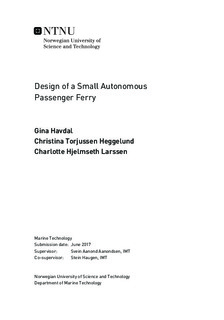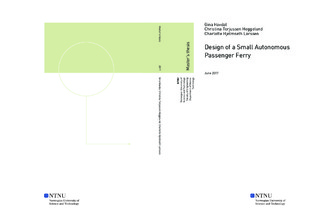| dc.description.abstract | The main objective of this study is to determine the design of an autonomous ferry to transport people between Ravnkloa and Fosenkaia in Trondheim. It will also be considered whether or not it will be a better solution than a bridge. The operational area of the ferry is limited to the 100 metres stretch between the two docks. The ferry should not require any personnel on board to operate, but it is assumed that a supervisor can oversee the operations from a land base. The surrounding elements of the system was outlined for easy adaptation, but not designed to full detail due to time limitations. The autonomous system itself was not considered directly as it is outside the team members area of expertise.
The work in this thesis follows the System Based Ship Design (SBSD) methodology, combined with the Risk Based Ship Design (RBSD) method. In order to apply both methods simultaneously, they were slightly adapted to fit the design study. A bigger emphasis has been put on the functional analysis in the SBSD approach. This makes it easier to determine a good solution for the design. The design study initiates with the mission statement, and sets the main functional requirements for the design based on this. Both relevant generic- and safety related functional requirements were set according to the main functions. The safety related functions were determined by performing a formal safety assessment. To reveal all possible solutions to the functional requirements, a brainstorming session was performed. The alternatives were continuously evaluated against relevant framework conditions and the least relevant ones excluded, thus limiting the final solution throughout the design process. The required area and volume on board, determined using model- and life size test, determined the initial main dimensions. The final design was evaluated on technical performance, economy and safety performance. Stability- strength- and resistance calculations were used to verify the design, in addition to determining the life cycle costs (LCC).
The result of this study is the design of an autonomous ferry with electrical power supply and a ramp used for mooring and entrance. The ferry is 9 m long with a beam of 4 m. The design draught of the vessel is 0.515 m. The ferry can transport up to 12 passengers, including three wheelchairs, and 30 kg luggage per person. There is also room for twelve bicycles on board. The building material is aluminium. The ferry superstructure is semi - open with two broad pillars supporting the roof. The ferry will dock at piers separated from other docks in the area. An information poster is located at the dock to inform passengers on relevant safety issues. The registration gates lock of the docking area to the people on the dock. Entry to the dock is done using a gangway. The design ensures that the passenger comfort is sufficiently good.
The ferry is able to transport all types of pedestrians, and is thus able to substitute a bridge. The weakness of the ferry option is that passengers may need to wait a few minutes to use the ferry. The ferry's life cycle costs were estimated at approximately NOK 2.4 million over 15 years. This is significantly lower than the price tag for the bridge, estimated at NOK 42 million. Thus, the the ferry is considered a good alternative. All functional requirements set to the design are considered fulfilled to a reasonable degree.
The methods applied for the design have weaknesses. Flaws in the RBSD methodology include a lack of accurate statistical information, the fact that the method is based on analysis of existing vessels, and that it is dependent on predetermined risk acceptance criteria. Flaws in the SBSD methodology include non existing statistical information on small and/or autonomous vessels. Required space for all systems was therefore set using existing equipment. Another flaw is that functional requirements may not cover all actual requirements for the vessel. For instance, bollards and ropes are required on board in case towing is necessary, but is not covered by any functional requirements.
The iterative nature of the design process indicate several relevant tasks for the further project work. It will be relevant to consider all aspects set by regulations. New aspects for consideration include design of land based dock systems and determination of access restrictions, required safety level, disclaimer of liability and technical requirements for autonomous vessels. Several aspects on board the vessel are also relevant. This includes heating cables in the ferry roof and main deck, verification of plate thickness, hull adaptation for welding and design of bicycle racks. The operational plan for the battery systems should be determined for the ferry operation to run as smoothly as possible. Finally, the damage stability for the vessel should be verified. | |

